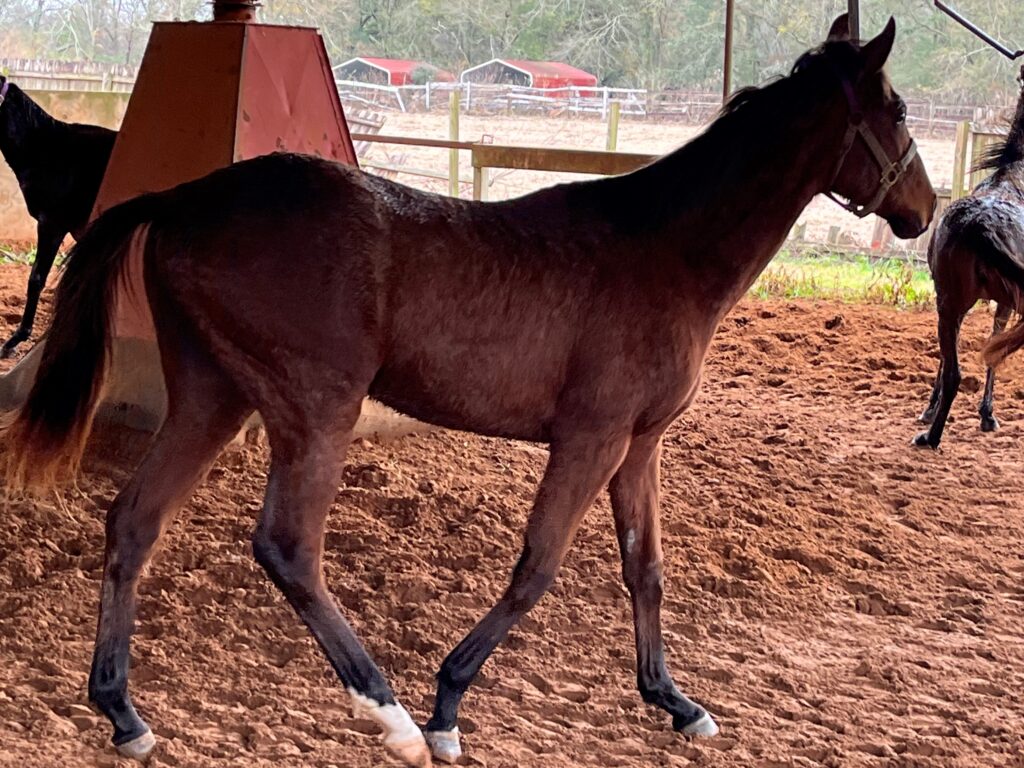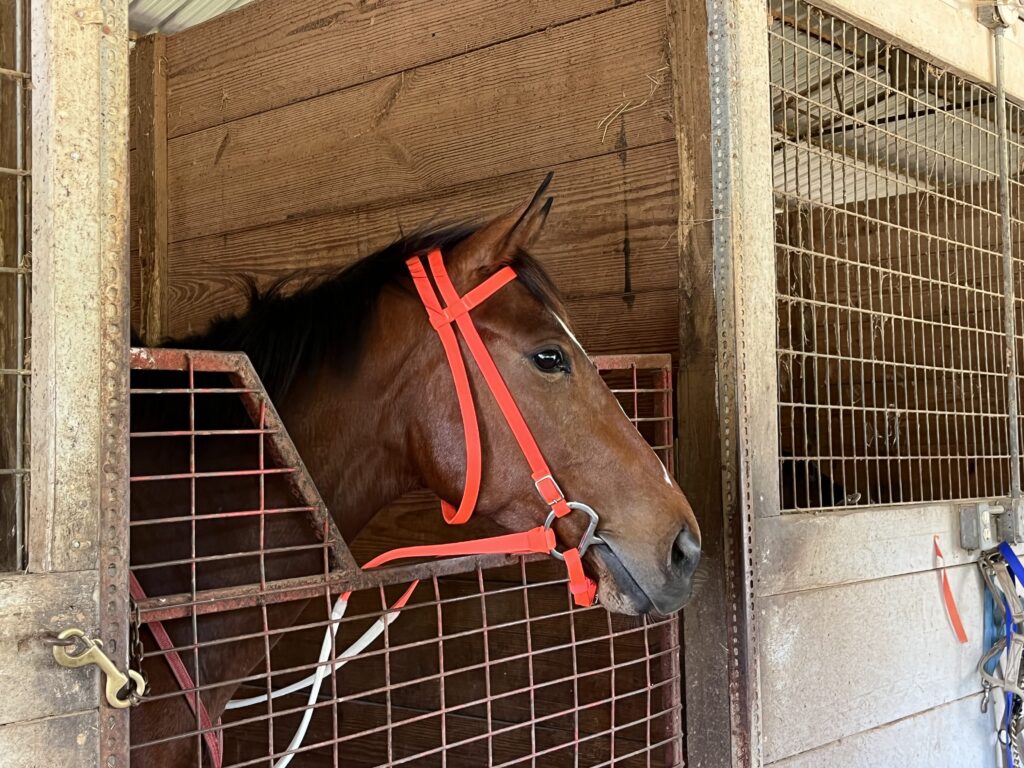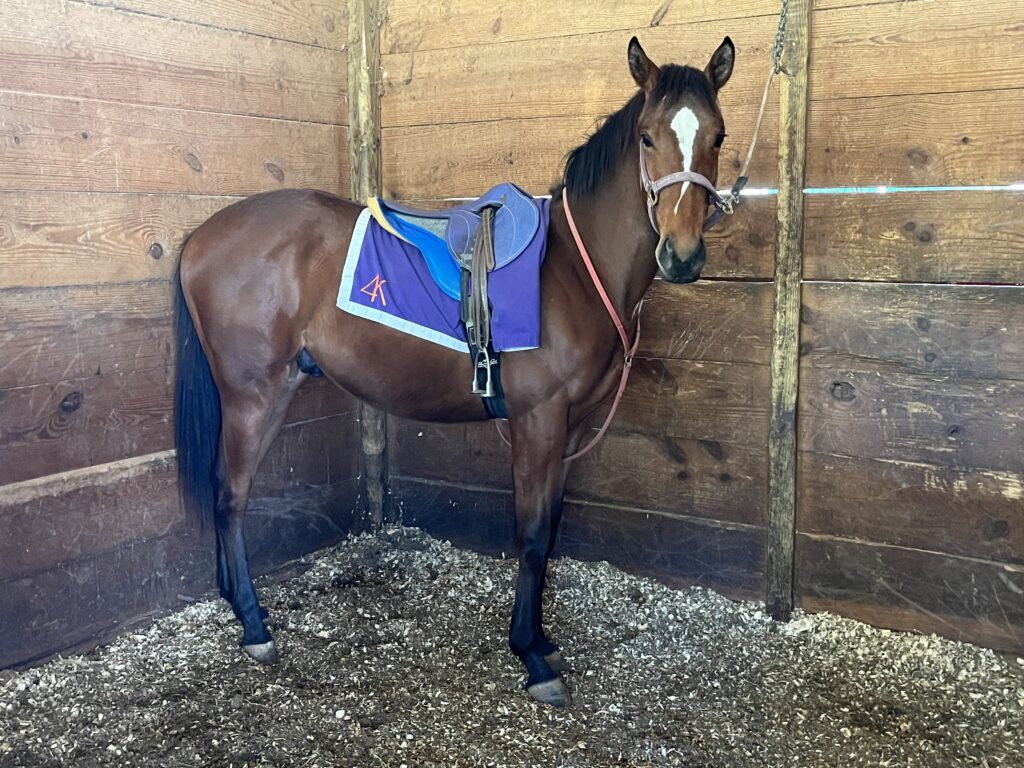Last updated: May 4, 2022
One of our horses stands at his stall gate and violently paws the ground. His persistent pounding of the stall floor has us worried he will eventually damage his feet or legs. We researched this behavior to find out why it started and how to prevent it.
Horses typically paw the ground when they want attention, are mad, frustrated, or bored. They stomp their feet when their lower legs are irritated. Common stimulants are wraps, horseflies, or an infestation of mites or other insects.
Horses paw the ground, it’s normal behavior, but what we are talking about is repetitive and constant stomping. It is irritating and can physically damage your animal.

Reasons horses paw the ground.
Instinctive
It’s natural for horses to paw the ground. Horses in cold climates often use their front feet to scrape snow and ice from the surface to expose the grass to eat.
Horses survived for thousands of years in the wild because they adapted to their environment. Horse breeds that evolved in hot climates typically have thin, light-colored coats; palomino Arabians are prime examples.
Cold climate horse breeds have thick coats and manes to provide warmth from the frigid elements. Besides physical traits, they also developed other survival instincts, and one is the ability to find food sources in harsh climates.
The above photo is of a Yakutian horse that lives in Siberia, where the temperature dips to 95 degrees below zero. To survive, they have to paw the deep snow and ice away to expose buried forage. Domestic horses rarely have to paw the ground to survive; however, it is an inherent trait.
If you’re interested in learning more about the Yakutian horse, I wrote an article about the differences between horses and ponies and dedicated a section to this unique breed.
Behavioral trait
Horses paw the ground when they are bored, frustrated, or impatient. If the behavior is left unchecked, it can become a deep-rooted behavioral problem that’s difficult to fix.
Boredom
Most horses are fine in a pasture, especially when in the company of other animals. The problem with stomping and pawing is much more prevalent in horses’ that are stall kept or tied for long periods.

If you notice your horse pawing the ground in a stall, adding some stall toys may help. Amazon sells a wide array of items designed to fend off stall boredom; you can click here to visit their site or here to read an article I wrote about horse toys.
Frustration
Horses that are tied longer than they think are necessary often get frustrated and stomp and paw the ground. Their frustration may be understandable; however, it’s not acceptable behavior.
In the relationship between you and your horse, you are dominant, not your horse. Horses understand their role in a herd, and there is only one leader. If you bend to the will of your horse, they will begin to believe that you’re a subordinate.
Letting a horse become the leader causes a host of problems. Some will start getting into your space, walk over you, bite you, and just become downright mean.
The best way to cure this problem is to untie your horse and work with him for a little while. If he starts pawing again, work him again. Get it in his head that when he paws, he will be worked. This method works on most horses.

Impatience
Impatient pawing typically occurs during feeding time. Most people have a feeding routine for their horses, and our animals begin to anticipate it. Some horses start pounding the floor ten or fifteen minutes before feed time.
Other horses start when they see you enter the barn. This behavior is unacceptable and should be tempered immediately because it will get worse.
If I have a horse that paws and acts up when waiting to be fed, his meal is skipped. Of course, I don’t starve the animal, he has hay in his stall, but he won’t get any grain feed unless he is behaving correctly.
If you give in to your animal’s demand to be fed, you’ve just handed over control, and this is not good. It won’t take long for your horse to understand his bad manners aren’t tolerated.
Currently, we have some young horses in training. They spend the night in a stall and we take them out at the same time every day and work with them. When one of them thinks we are taking too long she starts pawing the ground.
Reasons horses stomp
Leg irritation
Horses stomp when their lower legs are irritated. The obvious culprits are horseflies, but there are less apparent pests that also bother horses, such as mites.
Mites are a severe problem for horses with feathers. Feathers are the long hair that grows on the lower legs of horses as seen on Friesian horses and large draft horse breeds.
If you don’t see horseflies around your horse’s legs, then take the horse out of its stall and inspect the hair around its patterns. Mites are difficult to see, but they typically cause crustiness and flakiness of the lower legs’ skin.
If you believe your horse has mites, wash its legs thoroughly with antibacterial soap and apply a medicate salve. You also want to clean your animal’s stall and spray it with an effective insecticide to kill the insects before returning your horse.
If horseflies are the main insects bothering your animal, incorporate a fly control regime for your barn. Make sure you dispose of manure far away, use stall fans, and fly spray. If these steps don’t remedy the problem, try fly boots.
Pain
We had a horse with colic once, and its first symptom was stomping the ground. Colic is a severely painful stomach condition, and horses try many different movements to get relief.
Horses with colic react differently; some roll on the ground, look back and bite at their side and twitch their tail nervously.
Anger
When a horse is mad and ready to attack, they typically send a warning signal. The most common combination of signs is stomping their feet, pinning their ears, and swishing their tail.
When you see these actions take heed, you need to act. If you’re not experienced around horses, you need to move to a safe spot. However, the correct response is to walk forward and ask the horse to move.
It would be best if you started directing your animal to work and keep its legs moving. Don’t give an inch to an aggressive animal because it is attempting to gain dominance over you.
Pawing and Stomping can cause damage.
Horses are large animals, and their constant pawing the ground often creates holes in pastures, paddocks, and stall floors. Pawing and stomping can also damage stall doors, trailers, and fences.
But the most likely damage is going to happen to the horse. Injuries from pawing and stomping happen for various reasons. For example, horses reaching their front leg out to paw may get tangled in a gate or fence.
Horses can even reach over a low lead rope and get themselves in trouble. Besides problems associated with tangling, horses damage their hoofs and legs with excessive stomping and pawing.
As you’re likely aware, horses’ legs are fragile, so pounding feet into the ground can damage tendons and ligaments. had a young horse that stomped so often it often had swelling and we had a difficult time keeping shoes on her.
- LOOSE FITTING FLY BOOTS. Durable, lightweight & breathable plastic mesh protects your horse from painful fly bites. Prevents botflies from laying eggs & causing botfly larvae infestation
Prices pulled from the Amazon Product Advertising API on:
Product prices and availability are accurate as of the date/time indicated and are subject to change. Any price and availability information displayed on [relevant Amazon Site(s), as applicable] at the time of purchase will apply to the purchase of this product.
Stop pawing and stomping
Control your animal, as I discussed earlier, and keep your animal occupied. Suppose it’s exercised regularly; it is less likely to be bored. But now I’m going to discuss some items explicitly designed to hinder pawing.
Pawing chains
Pawing chains attach to a horse’s leg with a leather or nylon cuff. It doesn’t connect to anything else. It’s designed to rattle and create discomfort when a horse reaches out to paw.
It’s a harmless contraption used primarily on a horse when kept in a stall. It doesn’t seem to hurt the animal. I haven’t used one on our horses. I believe it’s best to work with the horse and get to the root of the problem.
Amazon sells pawing chains online and you can click here to see what they look like.
Pawing bands
Pawing bands work under the same premise as pawing chains with a little difference. Pawing bands attach loosely above a horse’s hoof and move up and down when they lift their legs.
The theory is that the band’s movement aggravates the animal and so it won’t move its feet to paw the ground. I haven’t used this product, but you can see them on Amazon’s site if you click this link.
Below is a helpful YouTube video showing how to correct a horse that paws while tied up.
Related articles:
- Why Do Horses Crib (Bite) on Wood? the Answer Isn’t Simple
- Why Do Horses Kick, and Can a Horse Kick Kill You?
- Why Do Horses Trip and Stumble So Much? 7 Reasons
- Is Your Horse Too Skinny to Ride? Let’s Find Out!
- What Is a Coggins Test and Why My Horse Needs One?
- Step-By-Step: How to Prepare a Horse for a Long Trip
- Why Does My Horse Have Diarrhea? Tips to Prevent and Treat

About the Author: Miles Henry
Lifelong Horseman | Racehorse Owner | Published Author
Miles Henry brings over 25 years of hands-on experience training and owning Thoroughbred racehorses. Raised with Quarter Horses and Appaloosas, he’s spent a lifetime learning from horses—on the track, in the barn, and in the field. Today, he runs a small but successful racing stable in Louisiana and shares real-world insights on HorseRacingSense.com, helping horse owners, fans, and bettors navigate the sport with confidence.
📚 Books: View Miles’s books on Amazon »
🎧 Podcast Guest: Animal Tales Ep. 32 |
YouTube Interview
📩 Newsletter: Sign up for racing tips and horse care advice »
🔗 Follow Miles:
Twitter |
Facebook |
YouTube




